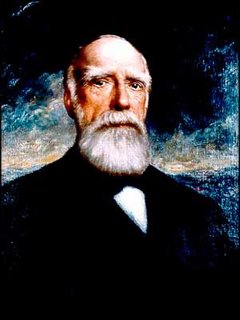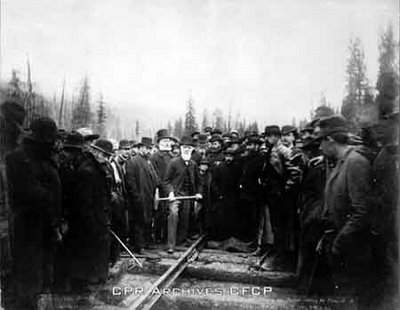
Writing on the life of the renowned Scotsman Donald A. Smith, also known as Lord Strathcona, is a severely daunting task. The man’s legacy consists of no less than the creation of the Canada that we live in today, especially for British Columbians, and the man himself was complicated by a duality (viewed as benefactor and burden in different parts of the country) that is extremely interesting. He went from living in near complete isolation amongst “the simplest of savages”(Willson, 102) in Labrador, to literally completing the railway across the whole of Canada, linking our provinces together and giving our producers access to the markets of the world through the port at Vancouver. While his actions built up parts of the nation, he was also responsible for several actions that would, on their own, make for a far less sterling reputation. Despite some contention, however, his financial success resulted in developments felt not only in this country, but throughout the world.
For a time Strathcona, who would later become, arguably, the most influential man in Canadian politics, was working at the trading post in “the barren shores of Labrador” (Preston, 15) where he would live amongst the “savages” of the northern Esquimaux tribes. In fact, Strathcona would encounter many of the native tribes of Canada through his work, one time writing home to his mother of having saved a native girl who had badly sprained her ankle, whom he carried back to her village, despite the fact that “the effluvia of [that] young lady was really overpowering.” (Willson, 177)
It would be incorrect to say, however, that his contact in Labrador was all unpleasant. In June , 1884, after much travel via native birchbark canoes, Mr. Richard Hardesty, the former Chief Trader from another region arrived at (then) Donald Smith’s trading post with his family on their way to Montreal. He arrived with his family, including his two sons and his daughter Isabella. The two texts that I drew mainly from differ on her age, one describing her as a “vivacious young lady of nineteen or twenty” who had studied at an English boarding school (Willson, 119), and the other as “a gentle, interesting little girl of twelve or fourteen years” who had caught and tamed a wild bird that she kept as a pet. (Preston, 16-17) What is known is that Isabella had been married to a Mr. Grant and a few months later she became Mrs. Smith on March 9, 1835. There was much “idle talk” about this arrangement, however, Donald Smith wasn’t as devious as some thought at the time; due to a lack of proper authorities, the marriage customs of Hudson’s Bay territories were “as it [was] in Scotland” where marriage was simply “mutual consent of the parties.” (Willson, 120) They would have a formal marriage, but it would be over fifty years later, across the Atlantic at the British Embassy in Paris. Here he showed his ability to act for himself, outside of the traditional rules that governed the more ‘English’ colonies, just as Canada’s views of marriage remain quite liberal today.
Finishing with his post in Labrador, Donald Smith’s contributions to the Canadian politics in general, and the building of the railroad in particular began in earnest. His various schemes and transactions made him and his cohorts sizable fortunes, but they still required help from the Canadian government to finish the railroad project. Here it is worth noting that it took a fellow Scot to exact the best revenge on him for his past defection from his party; “Sir John A. Macdonald insisted, as one of the conditions of the loan, that Donald A. Smith... [would] be asked, or rather, compelled formally to declare unbounded confidence in the political leader whom he had publicly abandoned in 1873... [which] was indeed drinking the cup of humiliation to the dregs.” It was said that “only a Scotchman could conceive of making a countryman of his own pay such a price as Sir John demanded from Donald A. Smith... however, [he] took his medicine like a man.” (Preston, 147-148) Because of this perseverance he was able to overcome his political hardships in order to fulfill his goal to complete the railway.
The problems associated with constructing the railway were not limited to Lord Strathcona’s personal political problems, as was seen in Manitoba, even after the rebellions of Louis Riel. Amongst all of the power and subsidies the railway company had accrued from the government “it was fully realized that the shackles the ‘Empire-Builders’ were forging on the general public could not be borne without entailing conditions of slavery,” and it was serious enough that “the public declared that they would have competitive railways at the cost of secession from eastern Canada, if necessary.” (Preston, 177) Armed citizens protect the construction of a crossing for an independent line to cross that of Smith and his people, and the result of which was Smith’s revenge in the form of the shipping of superior grain from America to Canadian markets at half the cost of moving local grain from Canadian farmers. The harshness of this act makes it important to remember that without the railway connection through to the Pacific it is possible that British Columbia may not have become a member of Canada. Amongst demands such as a federally funded project to build a university for the province (the University of British Columbia), a railway connection to eastern Canada was a must for British Columbia to join the confederation. Thus, Strathcona was not only responsible for Canadian politics and development within British Columbia, but was one of the primary reasons that British Columbia became a part of Canada at all - the first attempted ‘last spike’ Strathcona struck in British Columbia being converted into the jewel-encrusted spike that “Lady Strathcona used often to wear, as one of her most treasured possessions.” (Preston, 176)
Strathcona’s influence in Canada went beyond the realm of politics and railway construction. The blog has so far mentioned the “Strathcona Horse” as it stands today - another testament to the undying influence of Donald A. (as his friends called him) and his dedication to the British empire, and Canada in particular. It’s foundation was no different: During the Boer War the English were given help from all corners of the empire, but the British troops were not used to the terrain they were fighting on and the tactics of the men they were fighting. Lord Strathcona watched the events for a time with great concern, and offered the British crown a force of 700 mounted men from western Canada, to be armed and sent at his own expense, which the British welcomed whole-heartedly. The expedition cost Strathcona, known as much for his frugality as for his wealth, one million dollars out of his own money to aid the empire. The Strathcona Horse were so effective in the war that their enemies gave them the name “British Boers” out of respect for their fighting abilities. (Pedly, "The Strathcona Horse") This fighting force symbolized Strathcona’s Scottish solidarity with members of one’s own clan (in this case, the British empire that founded the North American colony), but it also served as an important chance for Canada to show its worth as a fighting force to her allies, even though it was still a newly formed nation, as it does to this day.
Strathcona is irrevocably tied into not only the identity of British Columbia, but also the identity of Canadian politics, commerce, and the identity presented to the rest of the world. Without Lord Strathcona the Canada that we know today could not have come into existence.
Works Cited:
Rev. Pedly, J. W., B.A.
Biography of Lord Strathcona & Mount Royal. Toronto, Canada: The J.L. Nichols Co. Limited, 1915
Preston, W.T.R.
The Life and Times of Lord Strathcona. Toronto, Canada: McClelland, Goodchild & Stewart Publishers, 19??
Willson, Beckless.
The Life of Lord Strathcona and Mount Royal, Volume I. New York: Houghton Mifflin Company, 1915
Photograph taken from Preston’s
The Life and Times of Lord Strathcona (see above).



